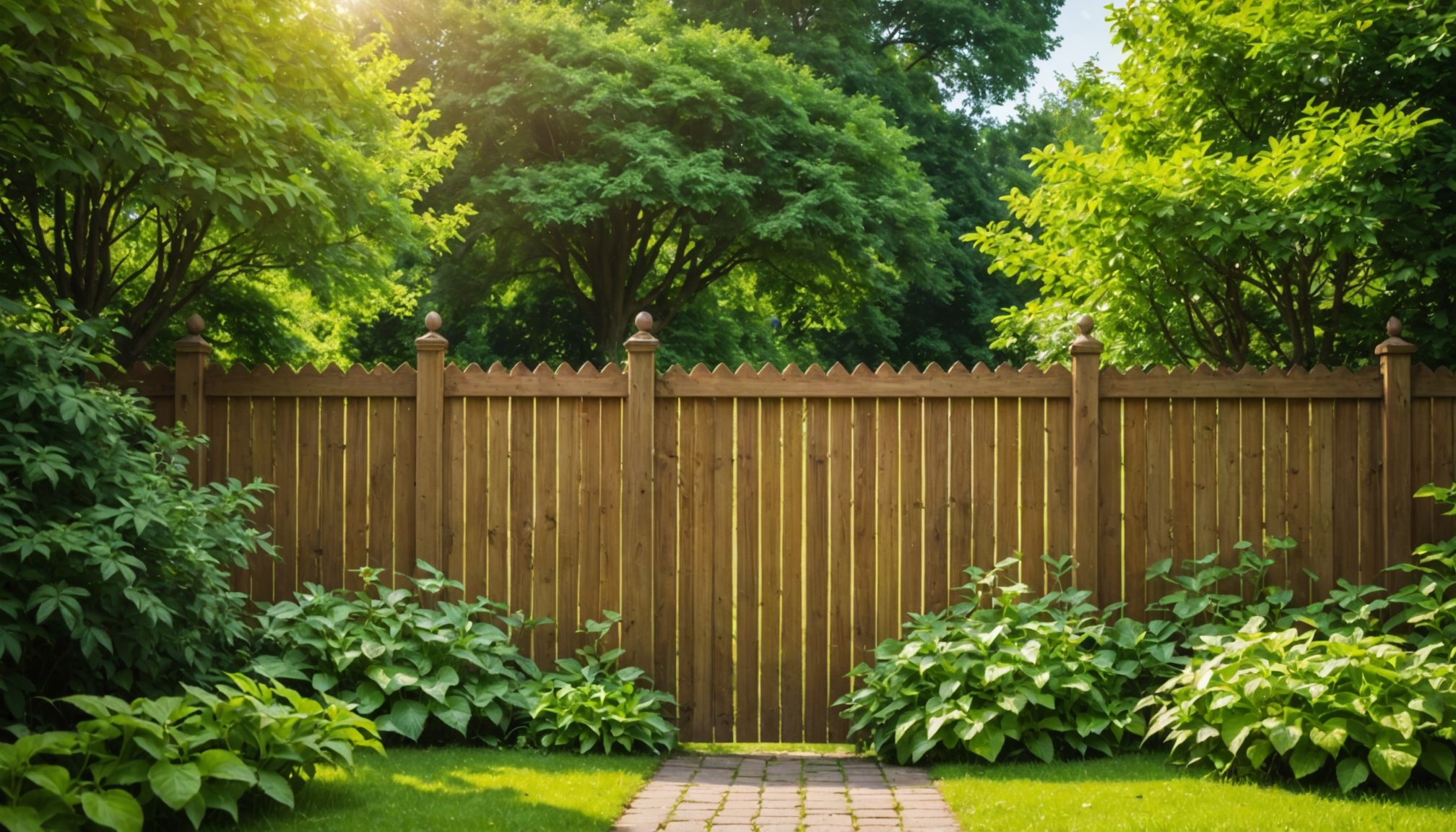When upgrading your fence, one of the most crucial decisions is selecting the right material. The choice of material not only affects the overall aesthetics of your exterior but also determines the durability, maintenance, and security of your upgraded fence. Understanding the characteristics of each material can help ensure you make the best choice for your family’s needs and property requirements.
The most common materials for fencing include wood, vinyl, metal, and composite, each offering unique benefits. Below is a comprehensive table comparing these materials on various factors such as longevity, maintenance requirements, cost, and environmental impact, which are essential to consider when planning a long-term investment like a fence upgrade.
| Material | Longevity (years) | Maintenance | Cost | Environmental Impact |
| Wood | 10-15 | High (requires staining/painting) | Medium | Varies (depends on sourcing) |
| Vinyl | 20-30 | Low (occasional cleaning) | High | Moderate (synthetic production) |
| Metal (Aluminum/Steel) | 20-50 | Low to Medium (check for rust) | High | Low (recyclable) |
| Composite | 25-30 | Low (requires occasional wash) | Very High | Moderate (mix of materials) |
Wood often appeals to homeowners looking for a classic appearance and the ability to customize the look through paints and stains. While the initial cost is moderate, wood requires regular maintenance to prevent deterioration and maintain its aesthetic appeal. This option can be quite demanding, almost akin to keeping the kitchen clean and organized; it necessitates a vigilant, ongoing effort.
Vinyl, on the other hand, offers ease of maintenance and is resistant to pests and rot, making it ideal for families seeking a low-maintenance solution. While the upfront costs can be higher, vinyl fences typically last longer than wood and offer a clean, modern look. Choosing vinyl is advantageous, especially if you want to minimize chore-related upkeep, much like hiring pros to handle a labor-intensive kitchen remodel.
Metal fences, such as aluminum or steel, are recognized for their strength and security. These materials require minimal maintenance and are often used in modern and contemporary settings. Despite the higher costs, metals are recyclable and offer robust protection, particularly advantageous for families prioritizing security and environmental considerations.
Composite materials combine wood fibers and plastic to deliver the aesthetic of wood with added durability. While the initial expense is considerable, composite fences do not rot like traditional wood and tend to be more environmentally conscious than pure plastic options. This option suits homeowners seeking a balance between natural beauty and low maintenance akin to a well-designed, easily managed kitchen space.
When choosing a fence material, consider your family’s lifestyle, aesthetic preferences, and long-term investment goals. Each material comes with specific advantages and trade-offs, so assessing these factors carefully will help ensure your upgrade meets your expectations, both functionally and financially.
Tools and materials you need
 To successfully undertake a fence upgrade, you’ll need a well-curated list of tools and materials. Proper preparation will not only make the process smoother but also ensure that the end result is durable and aesthetically pleasing. Here is a comprehensive guide to what you will need:
To successfully undertake a fence upgrade, you’ll need a well-curated list of tools and materials. Proper preparation will not only make the process smoother but also ensure that the end result is durable and aesthetically pleasing. Here is a comprehensive guide to what you will need:
- Measuring and Marking Tools:
- Measuring Tape: Essential for calculating the length and height of the fence and ensuring uniformity.
- Marking Paint or Chalk: Useful for marking out the fence line and post placement accurately.
- Level: Needed to ensure that your fence panels and posts are straight and level.
- Digging Equipment:
- Post Hole Digger or Auger: For creating holes deep enough for the fence posts.
- Shovel: A versatile tool for general digging and backfilling around posts.
- Materials:
- Fence Panels or Rails: Choose based on the type of material you have selected, whether it’s wood, vinyl, metal, or composite.
- Posts: Ensure they are sturdy and match the material of the panels for consistency in durability and aesthetics.
- Concrete Mix: Critical for securing the posts firmly into the ground to withstand external forces like wind and pressure.
- Gravel: Used at the base of the post holes for drainage and added stability, especially important in areas prone to extensive rainfall or damp conditions.
- Fastening Tools:
- Nails or Screws: Depending on the material, use rust-resistant varieties to avoid corrosion over time.
- Hammer or Power Drill: For driving in nails or screws efficiently, making the installation process faster and easier.
- Cutting Tools:
- Hand Saw or Circular Saw: Useful for cutting fence panels or posts to the desired size, ensuring precise fitting and finish.
- Protective Gear:
- Gloves: To protect your hands when handling rough materials or operating equipment.
- Safety Goggles: Essential when cutting materials or working with fasteners to protect your eyes from debris.
- Ear Protection: If using power tools, ear plugs or noise-canceling headphones are advisable to protect your hearing.
With the right tools and materials on hand, you can avoid unnecessary delays and frustrations, much like organizing every aspect of a kitchen remodel before hiring pros to handle the heavy lifting. This careful preparation not only enhances the quality of the upgrade but also ensures a safer and more satisfying construction experience for your family.
Step-by-step installation process
 Once you have gathered all the necessary tools and materials, it’s time to focus on the meticulous task of transforming your fencing vision into reality. This process, while straightforward, demands careful attention to detail to ensure your fence not only looks appealing but also functions effectively. Much like executing a well-thought-out kitchen remodel, attention to detail is paramount in achieving both aesthetic and functional satisfaction.
Once you have gathered all the necessary tools and materials, it’s time to focus on the meticulous task of transforming your fencing vision into reality. This process, while straightforward, demands careful attention to detail to ensure your fence not only looks appealing but also functions effectively. Much like executing a well-thought-out kitchen remodel, attention to detail is paramount in achieving both aesthetic and functional satisfaction.
First, begin by marking the boundaries where your fence will stand. You can use a measuring tape to locate the reference points on the ground accurately, ensuring the fence’s eventual layout matches your design intentions. Use marking paint or chalk to draw clear lines where the fence will be placed. These guides are essential to maintain a straight, aesthetically pleasing line and to avoid last-minute adjustments during installation.
Next, it’s time to dig the holes for your fence posts. Whether you’re using a post hole digger or an auger, ensure that the holes are deep enough to support the height of the fence, typically about a third of the post’s length. Adequate depth is crucial for stability and should be in line with local codes, much like following building regulations in a significant kitchen upgrade. Place a layer of gravel in the bottom of each hole for drainage and stability, which helps prevent water accumulation and potential wood rot.
Once the holes are prepared, position the fence posts within them, ensuring they are level and aligned. This step may require assistance, given the weight and the need for precision. Carefully fill the holes with concrete mix, which acts like the foundation of your posts, securing them in place. Allow the concrete to cure fully; this often involves several hours to a day, similar to allowing materials in a kitchen remodel to settle before introducing appliances or fixtures.
Install the fence panels or rails once the posts are stable. Whether you’re securing them with nails or screws, ensure that each panel is level and evenly spaced from the next. This alignment not only contributes to the fence’s overall aesthetic appeal but also affects its strength and durability. Consider using rust-resistant fasteners to combat corrosion, ensuring your fence stands the test of time despite environmental challenges.
Finally, apply any necessary finishes or treats to the fencing materials, such as stains or sealants for wood. This step enhances the visual appeal and prolongs the life of your fence, akin to selecting durable yet stylish countertops in a kitchen remodel. Maintenance starts from day one, setting the stage for reduced upkeep and ensuring your upgrade remains a family asset.
By following these detailed steps with precision and care, your fence installation process will transition smoothly, offering the satisfaction akin to watching a kitchen remodel come to successful fruition. Avoiding shortcuts and dedicating time to each phase ensures your upgraded fence not only meets your immediate needs but remains a valuable part of your property for years to come.
Enhancing fence aesthetics
 A freshly upgraded fence offers more than just improved durability and security; it serves as a canvas for creativity that enhances your outdoor living space. Adding visual appeal to your fence can transform your yard into a welcoming extension of your home, making it a perfect backdrop for gatherings with family and friends.
A freshly upgraded fence offers more than just improved durability and security; it serves as a canvas for creativity that enhances your outdoor living space. Adding visual appeal to your fence can transform your yard into a welcoming extension of your home, making it a perfect backdrop for gatherings with family and friends.
Start by selecting the right color or finish for your fence material. A new coat of paint or stain can rejuvenate tired wood, offering an opportunity to match the fence to the aesthetic of your house or garden. Consider neutral tones for a classic look or bold hues to create a focal point in your backyard. Don’t shy away from experimenting with textures through decorative treatments, like whitewashing or distressing, which add character and charm.
If painting feels too permanent, explore the addition of decorative elements such as latticework or trellises. These features can serve both aesthetic and functional purposes, supporting climbing plants that add greenery while providing additional privacy. Consider plants like clematis or jasmine, which bloom vibrantly and enhance your fence with natural beauty and fragrance.
Lighting plays a significant role in enhancing the aesthetic appeal of your fence. String lights, solar-powered sconces, or lanterns can illuminate the space invitingly, making your outdoor area functional even after sundown. Thoughtfully placed lighting can accentuate the details of your design, creating a mood that extends your home’s ambiance into the garden.
Incorporating features such as planters or hanging baskets can also elevate your fence’s visual appeal. These additions allow for seasonal color changes and personalized touches, almost like how one might choose decorative elements inside a newly remodeled kitchen. Using trailing plants or vibrant blooms can soften the lines of your fence and create a welcoming atmosphere.
Last but not least, think about investing in decorative panels or artwork. Metal or wooden art pieces can provide a contemporary edge or a rustic charm, depending on the look you’re aiming to achieve. These elements not only personalize your space but also echo the creativity often found in the heart of your home, enhancing the uniqueness of your property.
By focusing on these enhancements, you can turn your fence from a mere boundary marker into a centerpiece that contributes to the overall attractiveness of your home. It’s akin to finishing touches on a kitchen upgrade, bringing harmony and coherence between indoor and outdoor spaces, enhancing both functionality and aesthetic appeal.
Maintaining your upgraded fence
 Regular maintenance ensures your fence remains a durable and attractive feature of your property, much like how frequent upkeep keeps a kitchen in top condition after a remodel. Begin by conducting routine inspections to identify any areas that may require immediate attention. Look for loose fittings, damaged panels, or signs of rot and rust. These issues, if caught early, can be addressed promptly, preventing more significant problems in the long run.
Regular maintenance ensures your fence remains a durable and attractive feature of your property, much like how frequent upkeep keeps a kitchen in top condition after a remodel. Begin by conducting routine inspections to identify any areas that may require immediate attention. Look for loose fittings, damaged panels, or signs of rot and rust. These issues, if caught early, can be addressed promptly, preventing more significant problems in the long run.
Cleaning is critical for maintaining your fence’s appearance and structural integrity. Use a gentle power wash or garden hose to remove dirt, grime, and growth that accumulate over time. This helps preserve the material’s original finish, preventing degradation and extending its life. Depending on the material, consider applying a protective coating—such as a wood stain or sealant, or a rust preventative for metal fences—to safeguard it against environmental elements.
For wood fences, repainting or restaining should be scheduled every 2-3 years, depending on exposure to sunlight and weather conditions. This process not only revitalizes the fence’s color but also provides a protective layer that wards off moisture and insects. Vinyl and composite fences, on the other hand, require significantly less upkeep but should still be checked for cracks or splits that may compromise their appearance and durability.
Additionally, ensure the ground around your fence is kept clear of foliage that can trap moisture and lead to damage. Trim back any overgrown plants or tree branches to minimize debris contact with the fence surface. This maintenance step is akin to managing clutter in a freshly upgraded kitchen, ensuring a clean and functional environment.
Incorporating such routine maintenance practices helps you avoid costly repairs, much like preventive care in a kitchen saves you from sudden appliance failures. If maintenance seems daunting, consider hiring pros to handle these tasks, ensuring that your fence retains its charm and functionality with expert care.
Taking the time for regular maintenance not only extends the life of your fence but also enhances your property’s curb appeal, providing a welcoming environment for your family to enjoy for years.
In conclusion, upgrading your fence is a rewarding investment that enhances both the functionality and aesthetic appeal of your property. By choosing suitable materials, using the right tools, following a careful installation process, and maintaining your fence diligently, you ensure it stands the test of time. A well-designed fence adds value to your home, offering security and a personalized touch to your outdoor space, much like a thoughtfully remodeled kitchen enriches the heart of your home.

